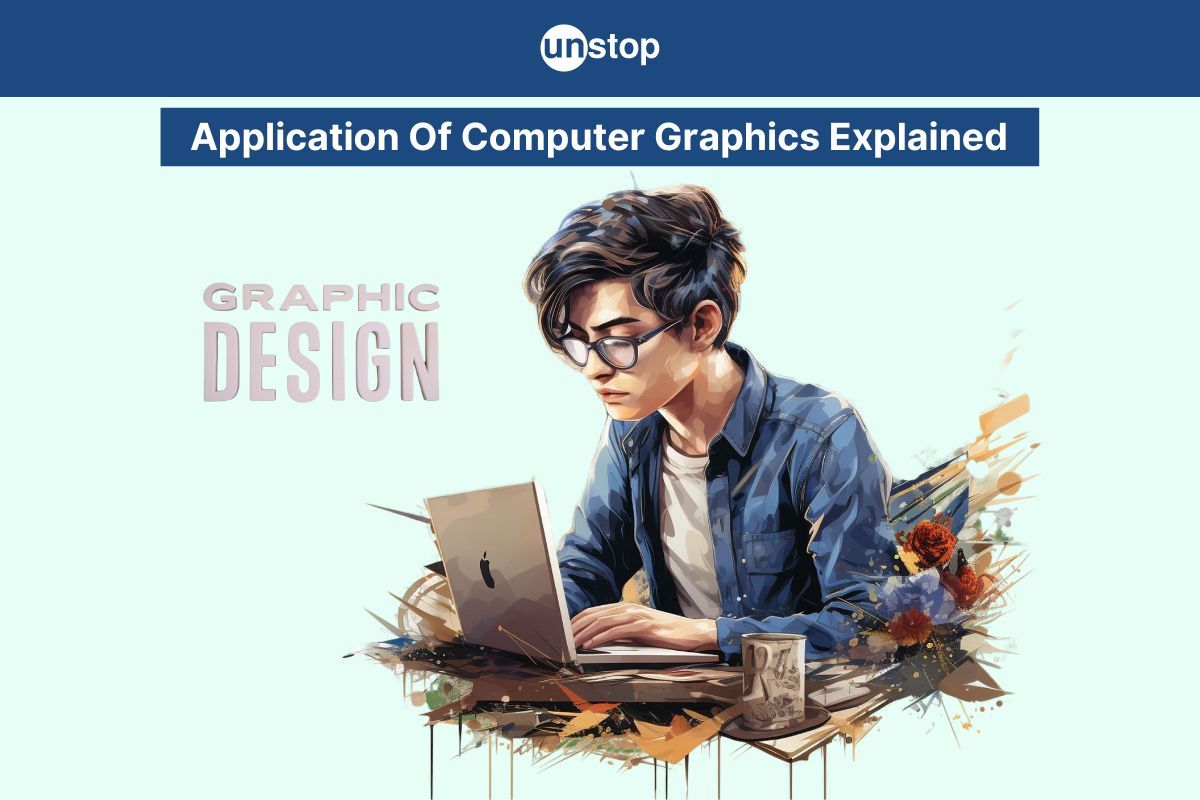- Understanding Computer Graphics & Types
- Concepts & Software For Computer Graphics
- Top 10 Applications Of Computer Graphics
- Advantages Of Application Of Computer Graphics
- Application Of Computer Graphics For Beginners
- Career Paths For Students In Application Of Computer Graphics
- Frequently Asked Questions (FAQ)
Application Of Computer Graphics: Top 10 Uses Explained

Exploring the application of computer graphics unveils a realm where creativity meets technology. Computer graphics are pivotal in various industries, from enhancing user interfaces to creating immersive virtual environments.
This article will take you through the significance and diverse computer graphics applications, shedding light on their impact on modern visual communication and design practices.
Understanding Computer Graphics & Types
To begin with, let us understand computer graphics and its types:
Raster Graphics
Images made of pixels arranged in a grid are known as raster graphics or bitmap images. These images are ideal for photographs and detailed visuals due to their ability to represent complex colour gradients.
Raster graphics excel at displaying intricate details but may lose quality when resized or scaled up significantly. This type of computer graphic is commonly used in photography editing software, digital painting programs, and web design applications.
Vector Graphics
Vector graphics involve geometric shapes defined by mathematical equations instead of pixels. These types of graphics can be resized easily without any loss in quality because they are not dependent on resolution.
Applications that benefit from vector graphics include logo design, illustrations, typography, and scalable icons. Designers prefer using vector graphics because they maintain clarity regardless of size adjustments.
Concepts & Software For Computer Graphics
Let us study the concepts and software tools for computer graphics:
Key Concepts
Computer graphics involve rendering, modelling, animation, and shading. Rendering is creating images from models, while modelling involves building 3D objects. Animation brings movement to still photos, and shading adds texture and colour. Understanding these concepts helps in creating stunning visuals.

For instance, when designing a video game character, modelling ensures the character's shape is accurately represented in the virtual world.
Software Tools
Popular software programs like Adobe Photoshop, Autodesk Maya, and Blender are essential for computer graphics work. These tools offer diverse features for rendering realistic scenes or editing images precisely.
For example, graphic designers often use Adobe Photoshop to manipulate photos by adjusting colours or adding effects. Similarly, animators rely on Autodesk Maya to create intricate 3D animations with lifelike movements.
Top 10 Applications Of Computer Graphics
Let us study the top 10 applications of computer graphics:
Film Industry
The application of computer graphics plays an indispensable role in the film industry by creating realistic visual effects. Professionals use advanced software to generate stunning animations and lifelike scenes, enhancing the overall cinematic experience for viewers.

Utilizing computer graphics allows filmmakers to bring imaginary worlds and creatures to life on screen, captivating audiences with immersive storytelling that would be otherwise impossible or cost-prohibitive using traditional methods.
Advertising Agencies
Advertising agencies leverage computer graphics to design eye-catching visuals for marketing campaigns. They can craft compelling advertisements that grab consumers' attention and effectively communicate brand messages by employing creative software tools.

The application of computer graphics in advertising enables companies to create memorable campaigns through visually striking images, engaging animations, and interactive designs that leave a lasting impact on target audiences.
Architecture
Computer graphics play a crucial role in architecture and interior design by creating virtual models and walkthroughs of buildings. This technology allows architects to visualize their designs accurately before construction begins, saving time and resources.
Students studying architecture can also benefit from computer graphics by better understanding complex structures through interactive 3D models.
Interior Design
In interior design, computer graphics help professionals effectively showcase their ideas to clients. Designers can present multiple options quickly by creating realistic renderings of spaces with different furniture layouts and colour schemes.
This not only enhances client communication but also speeds up the decision-making process.
Education
Educational institutions leverage computer graphics to enhance learning experiences for students. Through interactive simulations, concepts that are challenging to grasp through traditional methods become more accessible.
For instance, subjects like biology or physics can be taught using visually engaging animations that make learning fun and memorable for students.
Interactive Graphics
Interactive graphics engage users by allowing real-time manipulation, creating dynamic experiences. Users can interact with elements. Interactive graphics provide a hands-on experience where users can actively alter objects or navigate environments.
Non-Interactive Graphics
Non-interactive graphics offer passive viewing without the ability to influence the displayed content. Non-interactive graphics are static visuals lacking user input responsiveness and remain unchanged. They are commonly used in presentations and reports for data visualization.
Video Games
Video games, enjoyed by individuals of various age groups, have gained widespread popularity as a source of entertainment. They provide engaging experiences and allow for active participation through interactive gameplay.

In interactive games like Fortnite, players can control characters and make decisions affecting the game world.
Virtual Reality (VR)
Virtual Reality (VR) technology immerses users in a simulated environment, offering a truly interactive and engaging experience. Through virtual reality, individuals have the opportunity to discover unfamiliar environments, engage in gaming activities, and join online gatherings.
VR applications respond to user movements, enhancing immersion through interactive visuals.
User Interfaces (UI)
User Interfaces (UI) are the bridge between users and technology, enhancing user experience through intuitive design and functionality. UI design plays a crucial role in creating engaging and user-friendly digital experiences.
Websites and apps use interactive elements like buttons for navigation, making interfaces engaging.
Advantages Of Application Of Computer Graphics
Let us study the advantages and functions of computer graphics:
Data Visualization
Computer graphics are crucial in visualizing complex data, aiding in understanding and analysis. Computer graphics simplify intricate information for better comprehension by creating visually appealing representations.
Businesses can use computer graphics to present data in graphs, charts, or interactive visuals. This lets users quickly grasp trends and patterns without delving into extensive text-based reports.
Enhanced Communication
Through the use of computer graphics, conveying information visually becomes more effective than relying solely on text. Visual aids enhance communication by presenting concepts in a clear and engaging manner.
In educational settings, teachers leverage computer graphics to explain difficult concepts using diagrams or animations. This approach caters to various learning styles, making the content more accessible to students with diverse preferences.
Application Of Computer Graphics For Beginners
For beginners in computer graphics, let us study graphic design principles:
Graphic Design Principles
To apply computer graphics, beginners should grasp basic graphic design principles. Understanding concepts like colour theory and composition is crucial. These form the foundation for creating visually appealing designs.
Familiarizing with software tools such as Adobe Photoshop or Illustrator is essential for manipulating graphics effectively. These programs have many features to bring your creative ideas to life on the screen.
Regular Practice & Seeking Feedback
Regular practice is key to mastering the application of computer graphics. By consistently working on projects, beginners can enhance their skills and explore new techniques in design.
Seeking feedback from professionals or online communities provides valuable insights for improvement.
Career Paths For Students In Application Of Computer Graphics
Lastly, let us study some of the important career paths for students who are aspiring to become computer graphic designers:
Diverse Career Opportunities
Computer graphics offers various jobs like graphic designer, animator, game developer, and UI/UX designer. These roles involve creating visual content for different purposes. People who want to work in computer graphics usually need a degree in computer science or a related field.
This educational background provides the necessary foundation to succeed in entry-level positions within this field. Exploring diverse job opportunities allows professionals to specialize based on their interests.
For instance, graphic designers focus on creating visual concepts using computer software, while animators bring characters and scenes to life through animation techniques.
Continuous Learning
Continuous learning is vital to excelling in the field of computer graphics. Keeping up with new software tools and techniques helps professionals meet industry needs well.
Skill Development
Engaging with online tutorials, workshops, or advanced courses helps individuals enhance their skills further. Being proactive boosts creativity and creates new opportunities for career growth in computer graphics.
Conclusion
In conclusion, exploring computer graphics has unveiled its diverse applications across industries and its pivotal role in modern technology. From enhancing marketing strategies to revolutionizing entertainment experiences, computer graphics have become indispensable for visual communication and innovation.
Staying updated on the newest trends and advancements in computer graphics is crucial for professionals looking to make a big difference as this field keeps growing and changing.
Frequently Asked Questions (FAQ)
1. What are the main types of computer graphics?
There are two main kinds of computer graphics: raster graphics and vector graphics.
Raster graphics use pixels to create images, while vector graphics utilize mathematical equations to generate shapes and lines.
2. How do computer graphics benefit various industries?
Computer graphics are crucial in diverse fields such as marketing, entertainment, education, healthcare, architecture, and more. They enable better visualization of concepts, aid in simulations for research purposes, enhance user interfaces, and support innovative design processes.
3. What software tools are essential for creating computer graphics?
Popular software tools used for computer graphics include Adobe Photoshop for image editing and manipulation, Autodesk Maya or Blender for 3D modelling and animation creation, Adobe Illustrator for vector graphic design work, and Unity or Unreal Engine for game development with advanced visual effects.
4. Why is understanding interactive vs. non-interactive computer graphics important?
Interactive computer graphics allow real-time user interaction, like gaming applications or virtual reality experiences. Non-interactive ones involve static images or videos without user input options. Understanding the distinction helps in choosing the right approach based on project requirements.
5. How can beginners get started with learning computer graphics?
Beginners can start by exploring online tutorials on platforms like YouTube or Coursera to grasp basic concepts of computer graphics. They should also practice using software tools like Adobe Creative Suite or open-source alternatives to gain hands-on experience in creating digital visuals.
Suggested reads:
- Meet Navya Jhunjhunwala: A Food Blogger-cum-Graphic Designer Who Got Awarded For New York City's 'Pandemic Favorites
- Q7. Will Surprise You! Dare To Take This Quiz By Tata Group
- UTM'24: We Imagined A Conversation Between HRs, Students & TPOs. Here Are The Results
- 50+ Power BI Interview Questions (With Answers) For 2024 Job Interviews
- Evolution Of Operating System: Unveiling Generations & Trends
Instinctively, I fall for nature, music, humor, reading, writing, listening, traveling, observing, learning, unlearning, friendship, exercise, etc., all these from the cradle to the grave- that's ME! It's my irrefutable belief in the uniqueness of all. I'll vehemently defend your right to be your best while I expect the same from you!
Login to continue reading
And access exclusive content, personalized recommendations, and career-boosting opportunities.
Subscribe
to our newsletter
















Comments
Add comment